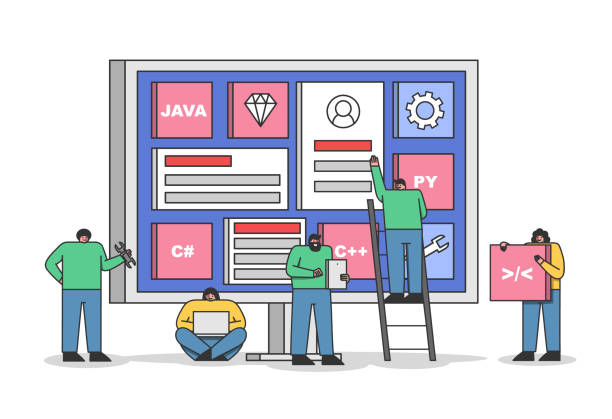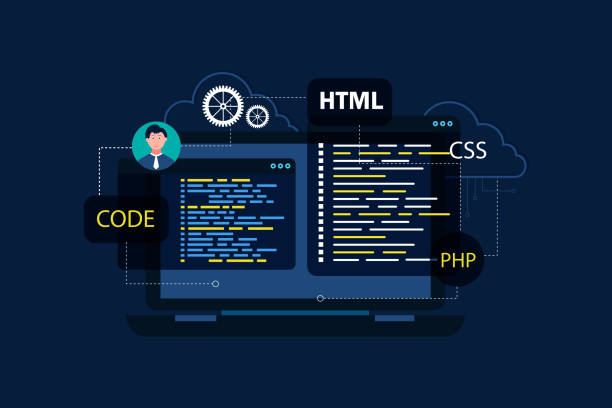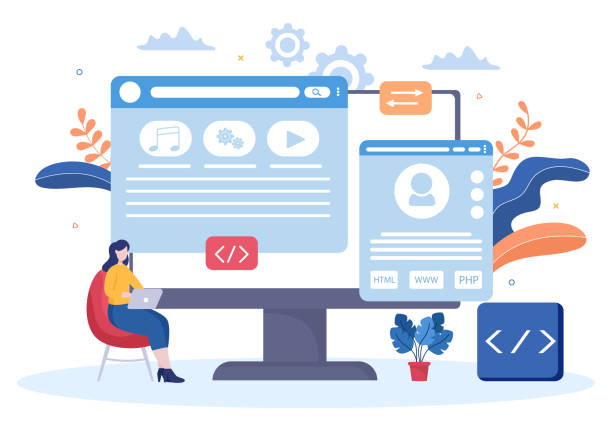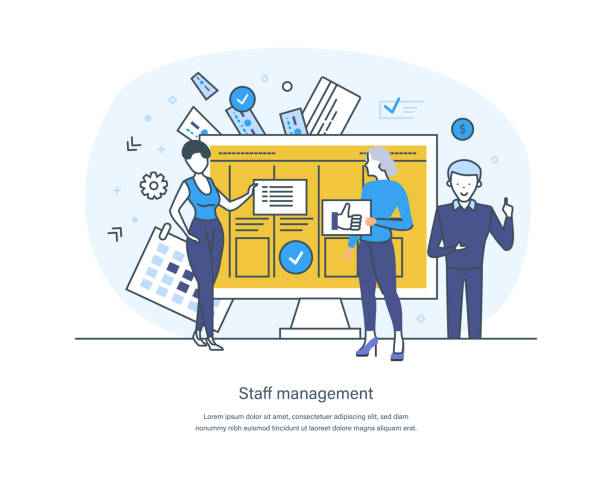An Introduction to the Importance of Secure Website Design and Its Foundations

In today’s world, where physical borders have faded and digital communications take precedence, secure website design is no longer an option, but an undeniable necessity.
Websites, as business storefronts, information platforms, and social interaction centers, are constantly exposed to cyberattacks.
Imagine an e-commerce website with thousands of customers suddenly being breached and customer credit card information stolen; this disaster not only harms the business’s reputation but can also lead to irreparable legal and financial consequences.
Therefore, focusing on #security and implementing #secure_web_design standards from the very early stages of development is crucial.
This preventive approach is far more effective and cost-efficient than trying to repair damages after attacks occur.
Web security is not just about using a firewall; it involves a set of processes, technologies, and policies that together form a strong defensive layer.
Secure website design goes beyond installing an SSL certificate or using strong passwords.
It is a culture that must flow through all layers of website development and maintenance.
From choosing secure hosting and continuously updating servers to secure coding, input validation, proper database management, and even educating users to choose complex passwords, all are part of this comprehensive process.
Neglecting any of these components can be a weakness that attackers exploit.
In the current era, where phishing attacks, DDoS attacks, SQL injection, and XSS attacks are frequently observed, #awareness and #prevention play a central role in maintaining online security.
Many organizations realize the depth of their vulnerabilities only after cyberattacks occur, at which point compensating for damages will be very difficult and costly.
Therefore, investing in secure website design and development is, in fact, an investment in the future and sustainability of your business.
This article comprehensively explores various dimensions of this field to provide a complete guide for building robust and impenetrable websites.
Are you bothered by losing customers due to your e-commerce site’s outdated appearance or slow speed? Rasawweb’s expert team solves these problems with professional e-commerce website design!
✅ Increased customer trust and brand credibility
✅ Blazing speed and excellent user experience
Get a free consultation with Rasaweb right now ⚡
Common Cyber Security Threats to Websites: Knowing the Enemy for Better Defense

To achieve secure website design, we must first know the enemy.
The cyber world is full of threats that target websites every moment.
Understanding these threats and being aware of how they operate is the first step in protecting your digital assets.
One of the most common and dangerous attacks is #SQL_Injection.
In this attack, the attacker attempts to gain access to the database, modify information, or steal it by injecting malicious SQL code through website input forms.
This attack can lead to the exposure of sensitive user information, data deletion, or even complete control over the database.
Websites that do not properly validate user inputs are highly vulnerable to this type of attack.
Another highly prevalent attack is called #Cross-Site_Scripting (XSS).
In an XSS attack, the attacker injects malicious JavaScript code into the website, which is then executed by other users’ browsers.
These codes can steal user cookies, expose sensitive information, or even alter the website’s appearance and redirect users to phishing websites.
XSS attacks typically occur through comment forms, forums, or any place where users can submit their content.
#DDoS (Distributed Denial of Service) attacks are also serious threats that take a website offline by sending an enormous volume of fake traffic to its server.
The goal of these attacks is usually to cripple website services and cause financial or reputational damage.
Furthermore, #phishing attacks, which aim to trick users into revealing sensitive information like passwords and banking details, remain a serious threat to online security.
Other threats such as #Broken_Authentication, which occurs due to weaknesses in user login systems, and #Insecure_Deserialization, which can lead to the execution of malicious code on the server, are also significant vulnerabilities.
Also, #Brute_Force attacks, where the attacker attempts to gain access to a user account by trying various password combinations, remain effective.
Precise knowledge of these threats and understanding how attackers exploit vulnerabilities is a fundamental step in implementing appropriate defensive mechanisms and ensuring #comprehensive_site_security.
This knowledge helps developers and website administrators prevent their website from becoming an easy target by adopting preventive security measures.
A secure website design must consider these threats and provide suitable solutions to counter each of them.
Fundamental Principles of Secure Web Design: From Coding to Configuration

Implementing a secure website design requires adherence to specific principles and standards that must be considered from the very beginning of the development process.
These principles include topics ranging from secure coding to proper server configuration and the use of appropriate tools.
One of the most important principles is Input Validation.
Any data entered into the system by the user, whether in forms or URL parameters, must be carefully reviewed and filtered.
Improper input validation opens the door to attacks such as SQL Injection and XSS.
Developers should assume all user inputs are malicious and sanitize them before any processing or storage.
Another principle is the use of the HTTPS protocol, which is activated via SSL/TLS certificates.
HTTPS encrypts traffic between the user’s browser and the website server, preventing eavesdropping, tampering, or forgery of information.
This is not only vital for user privacy but also has a positive impact on SEO and website ranking in search engines.
Furthermore, proper Error and Log Management is also of high importance.
General error messages, instead of detailed information about the system’s internal structure, should be displayed to the user so that attackers cannot use them to identify vulnerabilities.
Also, accurate and regular logging of system events (logs) enables the tracking of attacks and detection of suspicious patterns.
Secure Session Management is also essential for secure website design.
User sessions should have a defined lifespan and be properly destroyed after inactivity or user logout.
Using Secure Cookies and avoiding the storage of sensitive information in them are other important points in this regard.
Also, Least Privilege, meaning that each user or process only has access to the minimum necessary permissions to perform their tasks, is a vital security principle.
This principle prevents the spread of vulnerabilities if a specific section is breached.
Finally, continuous training of the development team on the latest threats and best secure coding practices will ensure the long-term stability of website security.
A #comprehensive_approach to security, encompassing all these principles, is essential for any web design project.
Key Differences in Security Approaches
| Security Aspect | Traditional Approach (Insecure) | Modern Approach (Secure) |
|---|---|---|
| Input Validation | Trusting user input, insufficient filtering. | Strict validation on server and client side, use of whitelist. |
| Communication Protocol | Using HTTP (unencrypted communications). | Mandatory use of HTTPS with SSL/TLS certificate. |
| Error Management | Displaying detailed server and database errors to the user. | Displaying general errors, logging detailed errors in secure logs. |
| Password Management | Storing passwords in plain text or weak hash. | Using strong hashing algorithms (e.g., bcrypt) with salt. |
| Updates | Irregular updates of OS, frameworks, and libraries. | Regular and automatic updates, quick security patches. |
The Role of SSL/TLS Certificates in Web Security: Encrypted Communications

On the path to achieving a secure website design, the use of SSL/TLS certificates is of particular importance.
These certificates convert the HTTP protocol to HTTPS, which means encrypting all data exchanged between the user’s browser and the website server.
Without HTTPS, information such as usernames, passwords, credit card details, and other sensitive data are sent in plain text, and anyone with network access can easily eavesdrop on them.
This situation makes your website highly vulnerable to #Man_in_the_Middle attacks, where an attacker can intercept the communication between two parties and tamper with or steal information without their knowledge.
SSL/TLS certificates not only provide #encryption but also perform website #authentication.
This means they assure users that they are connecting to the legitimate website and not a fake one created by attackers.
This is especially crucial for banking websites, online stores, and any platform that handles users’ financial or personal information.
SSL certificates come in different types, including: #DV (Domain Validation), which only verifies domain ownership and is usually suitable for small websites and blogs; #OV (Organization Validation), which also verifies the organization’s identity and is more suitable for businesses; and #EV (Extended Validation), which has the strictest level of validation and displays a green address bar with the organization’s name, providing the highest level of trust to users.
In addition to security aspects, using HTTPS also has significant benefits for #SEO (Search Engine Optimization).
Search engines like Google rank websites that use HTTPS higher in search results.
This means that secure website design with HTTPS can help your website gain more visibility.
Proper SSL/TLS implementation involves ensuring the server is configured to use the strongest encryption algorithms and newer TLS protocols (such as TLS 1.2 or TLS 1.3) and disabling older, insecure SSL versions.
Regular maintenance of certificates and ensuring they do not expire is also crucial, as expired certificates can lead to security warnings for users and a loss of their trust.
Choosing a reputable certificate authority and adhering to best implementation practices is essential to fully leverage the security and trust-building benefits of this technology.
Are you tired of your company’s website not being seen as it should be, losing potential customers? Rasaweb solves this problem forever with professional and effective website design!
✅ Increased brand credibility and customer trust
✅ Attracting targeted sales leads
⚡ Contact us now for a free consultation!
Database Management and Information Security: The Backbone of Data Protection

Secure website design is impossible without special attention to database security.
The database is the heart of every website, containing vital user information, content, and system settings.
A database breach can lead to the most catastrophic scenario for a website, resulting in the exposure of personal, financial, or even complete loss of data.
Therefore, implementing strong security measures for the database is one of the main pillars of any web design project.
One of the most important measures is #database_access_restriction.
Web scripts should not be allowed to connect to the database using a high-privilege user (like root).
Every application or part of the website should have access to the database with the minimum necessary permissions to perform its tasks.
Furthermore, encrypting sensitive information in the database is crucial.
User passwords should never be stored in plain text.
Instead, strong one-way hashing functions should be used with #salt (a random string).
This method protects user passwords even if the database is breached and prevents Rainbow Table attacks.
Other sensitive information, such as credit card details, should also be stored in an encrypted form or processed through secure payment gateways in compliance with PCI DSS standards.
Using #Stored_Procedures and #Prepared_Statements in database queries is an effective method to prevent SQL injection attacks.
These methods ensure that user input data is not executed as SQL commands but is only processed as data.
Secure configuration of the database server is also of high importance.
This includes disabling unnecessary ports, changing default ports, and using a #firewall to restrict database access only through authorized applications.
Also, #regular_and_secure_backups of the database and storing them in secure, separate locations allows for quick data recovery in case of an attack or system failure.
Continuous monitoring of database logs to identify suspicious activities or intrusion attempts is also an important preventive measure.
In general, a secure website design requires a comprehensive strategy for database protection that includes all these layers of defense.
Ignoring any of these measures can lead to serious vulnerabilities and the loss of critical information.
Penetration Testing and Website Vulnerability Assessment: Simulating Attacks for Better Defense

After implementing security measures in the secure website design process, the next crucial step is #Penetration_Testing and #Vulnerability_Assessment.
These processes help you identify and address potential security weaknesses and gaps before attackers discover and exploit them.
Vulnerability assessment typically involves using automated tools to scan the system and identify known vulnerabilities.
These tools can examine thousands of potential weaknesses in code, server configurations, or third-party libraries and provide a report of their findings.
While these tools are very useful for identifying common and generic vulnerabilities, they lack the ability to discover more complex and logical vulnerabilities.
This is where penetration testing comes into play.
#Penetration_testing is a controlled simulation of a real cyberattack performed by security experts (known as penetration testers or pentesters).
Pentesters attempt to breach the system using techniques and tools employed by real attackers.
The goal of this test is not only to identify vulnerabilities but also to assess their impact and discover ways in which an attacker could use several small vulnerabilities to achieve a larger breach.
Penetration testing can involve #Black_Box testing (without knowledge of internal structure), #White_Box testing (with full access to code and infrastructure), or #Gray_Box testing (with limited access).
Regular penetration testing, especially after major website changes or the release of new features, is essential for maintaining #sustainable_site_security.
Findings from penetration tests should be carefully documented, and the development team must address them as soon as possible.
This is a cyclical process; after vulnerabilities are fixed, tests must be performed again to ensure that the corrections have been applied correctly and no new vulnerabilities have been introduced.
Secure website design is a continuous process, and penetration testing is an integral part of this process that helps organizations gain a realistic view of their security posture and take necessary measures to strengthen it.
Investing in this process ultimately contributes significantly to protecting reputation, data, and digital assets.
Updates and Continuous Maintenance for Security: Keeping the Defensive Wall Alive

Another critical aspect of secure website design is #continuous_updates and #active_maintenance.
Websites are living systems that are constantly changing and evolving.
Underlying software, Content Management Systems (CMS) like WordPress or Joomla, plugins, themes, programming libraries, and even server operating systems all receive regular updates.
These updates often include fixes for discovered #security_vulnerabilities.
Ignoring these updates means leaving backdoors open for attackers to exploit known weaknesses for which patches have already been released.
For example, a popular #Content_Management_System (CMS) like WordPress is a prime target for attacks due to its widespread use.
Whenever a new vulnerability is discovered in the WordPress core, or in one of its widely used plugins or themes, attackers quickly begin scanning websites to find vulnerable versions.
If your website is not updated, it can be easily breached.
Therefore, a regular plan for checking and applying updates, whether manually or using automated tools, is essential for any website.
This includes updating the CMS core, all plugins and themes, as well as server-side software like PHP, MySQL, and web servers (such as Apache or Nginx).
Beyond software updates, #preventive_maintenance also includes items such as #regular_backups of all website data (files and database).
These backups should be stored in a secure location separate from the main server to allow for quick website recovery in case of a security incident or hardware failure.
#Continuous_monitoring of website traffic, server logs, and suspicious activities is also an important part of security maintenance.
Monitoring tools can help you identify anomalies and react quickly to potential threats.
In summary, secure website design is not a static process but an ongoing commitment to protecting digital assets and users, strengthened by continuous updates and active maintenance.
These measures protect your website against new and evolving threats and ensure its stability.
Client-Side Security and the Role of Users in Maintaining Security: The Front Line of Defense

In the discussion of secure website design, the focus is often on server-side security and backend coding, but client-side security and the role of users themselves in this process are equally important.
Even if your website is technically flawless, a weakness on the client-side can nullify all security efforts.
Educating and raising awareness among users is the backbone of #client-side_security.
Users must be aware of the importance of using strong and unique passwords, the dangers of phishing attacks, and the necessity of protecting their personal information.
A weak password like “123456” or “password” can be easily guessed by attackers, providing them with access to the user account.
One of the most important security measures that should be recommended and, if possible, mandated for users, is #Two-Factor_Authentication (2FA).
2FA provides an additional layer of security, meaning that even if an attacker knows the user’s password, they cannot access their account.
This method typically involves receiving a code via SMS, an authentication app (like Google Authenticator), or using physical security keys.
Also, implementing #Login_Throttling mechanisms can prevent Brute Force attacks aimed at guessing passwords.
After a few unsuccessful attempts, the system should block logins for a specific period or use CAPTCHA.
Furthermore, secure website design must implement #Secure_Session policies.
User sessions should have a defined lifespan and expire after a certain period of inactivity.
Also, users should be encouraged to #Secure_Logout from their accounts after finishing their work, especially on public computers.
Technically, websites should use HTTP security headers like Content Security Policy (CSP), X-XSS-Protection, and X-Frame-Options to prevent XSS, Clickjacking, and other client-side attacks.
Finally, continuous education and informing users about the latest security threats and best practices for maintaining online security are of paramount importance.
Aware users themselves serve as a strong defensive layer for the website and can help identify and report suspicious activities.
Did you know that poor online store design can drive away up to 70% of your potential customers? Rasaweb transforms your sales with professional and user-friendly e-commerce website design.
✅ Significant increase in sales and revenue
✅ Full optimization for search engines and mobile
⚡ [Get a free consultation from Rasaweb]
The Future of Secure Website Design and Upcoming Challenges: New Horizons in Web Security

With the continuous advancement of technology, the field of secure website design is also constantly evolving.
While we strive to protect our websites against current threats, attackers are also developing new and more sophisticated methods for infiltration.
Therefore, understanding the #future_of_web_security and upcoming challenges is essential for every developer and website owner.
One of the most important future trends is the #use_of_Artificial_Intelligence_and_Machine_Learning in cybersecurity.
These technologies can be used to identify abnormal patterns in network traffic, detect malware, predict attacks, and automate responses to security incidents.
This can significantly increase the speed of reaction to threats and reduce the need for human intervention.
However, AI is also a double-edged sword; attackers can also use it to develop smarter and more targeted attacks, such as #advanced_phishing or identifying unknown vulnerabilities (Zero-day exploits).
Another challenge is #IoT_Security (Internet of Things Security).
With the increasing number of internet-connected devices, from smart home appliances to industrial sensors, websites and cloud platforms that manage these devices are exposed to new threats.
A security weakness in an IoT device can become an entry point for breaching the entire network.
Therefore, secure website design must also consider security implications for communication with IoT devices.
The emergence of #Quantum_Computing also poses a long-term but serious challenge to current security.
Quantum computers possess unparalleled computational power that can easily break current encryption algorithms (which form the basis of web security).
This necessitates the development and implementation of #Post-Quantum_Cryptography.
Meanwhile, #API_Security will also gain increasing importance, as many websites and applications rely on numerous APIs for their functionality.
Any vulnerability in an API can be easily exploited.
Ultimately, secure website design in the future will require a more comprehensive and adaptable approach that can keep pace with evolving threats and leverage emerging technologies to strengthen cyber defenses, while also being prepared to tackle unprecedented challenges.
Summary and Final Recommendations for Secure Website Design: Practical Steps for a Robust Website
At the end of this comprehensive guide on secure website design, it is essential to re-emphasize the importance of a comprehensive and continuous approach.
Web security is not a destination but a continuous journey that requires constant attention and updates.
To ensure maximum security for your website, always keep the following key recommendations in mind and implement them throughout all stages of development and maintenance:
- Mandatory HTTPS Implementation: Always use valid SSL/TLS certificates and ensure all website traffic is encrypted via HTTPS.
This is the first and most fundamental step in protecting user data. - Strict Input Validation: Never trust data coming from the user.
Carefully filter and sanitize all inputs on the server-side to prevent attacks like SQL Injection and XSS. - Secure and Up-to-Date Coding: Follow best secure coding practices.
Choose secure frameworks and libraries and update them regularly.
Avoid storing sensitive information in plain text. - Database Security: Use users with the principle of least privilege for database access.
Store passwords as hashed values with salt.
Use Prepared Statements for queries. - Strong Password and Authentication Management: Encourage users to use strong passwords and provide Two-Factor Authentication (2FA) capability.
Implement anti-Brute Force mechanisms. - Regular Updates: All website components, including the CMS core, plugins, themes, server software, and operating system, must be regularly updated to address known vulnerabilities.
- Backup and Recovery: Regularly back up your website and database, and store backup copies in a secure location off the main server.
Test quick recovery capabilities. - Monitoring and Penetration Testing: Continuously review security logs and monitor for suspicious activities.
Conduct regular penetration tests and vulnerability assessments by experts. - Education and Awareness: Educate your development team and website users about the latest security threats and best practices for information protection.
Secure website design is a shared responsibility involving all stakeholders, from developers and website administrators to the users themselves.
By following these recommendations, you can build a robust #digital_fortress for yourself and your users that is resilient against many cyberattacks and gains user trust.
Remember that security is an ongoing process, and steps must always be taken to strengthen and improve it.
Frequently Asked Questions
| Row | Question | Answer |
|---|---|---|
| 1 | What is secure website design? | Secure website design is the process of building websites with security measures in mind from the early stages of development to protect them against cyberattacks, unauthorized access, and data loss. |
| 2 | Why is secure website design important? | Site security is crucial for maintaining user trust, protecting sensitive information (personal and financial), preventing brand reputation damage, and complying with privacy and security regulations (such as GDPR). A security breach can lead to financial and legal damages. |
| 3 | What are the most common cyberattacks a website faces? | Some of the most common attacks include SQL Injection, Cross-Site Scripting (XSS), Distributed Denial of Service (DDoS), Brute Force, and credential stuffing attacks. |
| 4 | What is SQL Injection and how to prevent it? | SQL Injection is a type of attack where an attacker attempts to manipulate the database or extract information by injecting malicious SQL code into website inputs. To prevent it, use Prepared Statements/Parameterized Queries, ORM (Object-Relational Mapping), and strict input validation. |
| 5 | What is Cross-Site Scripting (XSS)? | XSS is a type of attack where the attacker injects malicious scripts (usually JavaScript) into web pages that are then executed by other users’ browsers. This can lead to the theft of cookies, session information, or alteration of the website’s appearance. |
| 6 | How can Brute Force attacks on login pages be prevented? | To prevent Brute Force, use CAPTCHA, limit the number of unsuccessful login attempts (Account Lockout), Two-Factor Authentication (2FA), and enforce complex and long passwords. |
| 7 | What is the role of HTTPS in website security? | HTTPS uses SSL/TLS to encrypt communication between the user’s browser and the website server. This prevents eavesdropping, tampering, or forgery of information during transmission and increases user trust. |
| 8 | What is the importance of Input Validation in security? | Input validation is the process of checking and sanitizing data entered by the user. This prevents the injection of malicious code, XSS, SQL Injection, and other vulnerabilities, ensuring that the data conforms to the expected format. |
| 9 | Why is regular updating of website systems and software essential? | Regular updates of the operating system, CMS (like WordPress), plugins, themes, and libraries used, fix known security vulnerabilities. Hackers often exploit weaknesses in outdated software to gain unauthorized access. |
| 10 | What role does regular backup play in secure website design? | Regular and tested backups of website data (database and files) are a vital layer of defense against data loss due to cyberattacks, human error, or hardware failure. This allows for quick website recovery in case of a disaster. |
And other services of Rasaweb Advertising Agency in the field of advertising
Smart Brand Identity: A fast and efficient solution for increasing sales with a focus on Google Ads management.
Smart Google Ads: Designed for businesses looking to increase website traffic through custom programming.
Smart Direct Marketing: Designed for businesses looking to improve SEO ranking through custom programming.
Smart Sales Automation: Transform digital branding with the help of attractive UI design.
Smart Advertorials: A professional solution for attracting customers with a focus on precise audience targeting.
And over a hundred other services in the field of internet advertising, advertising consulting, and organizational solutions
Internet Advertising | Advertising Strategy | Advertorial
Sources
Principles of Secure and Robust Website Design in Zoomit
Solutions for Increasing Website Security in Aftab News
Comprehensive Website Security Guide in Webramz
Key Tips for Website Stability and Robustness in Miad Team
? To elevate your business in the digital world, Rasaweb Afarin, by offering innovative marketing solutions and fast and professional website design, is by your side to help you have a powerful and lasting presence.
📍 Tehran, Mirdamad Street, next to Bank Markazi, Kazeroun Jonoubi Alley, Ramin Alley, No. 6



